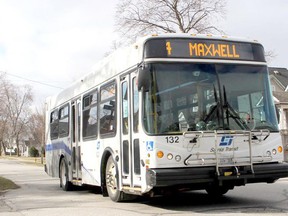Sarnia may purchase gas, diesel and electric buses in 2024.

Sarnia may purchase gas, diesel and electric buses in 2024.
Advertisement 2
Article content
Council budget deliberations start Dec. 5, but the city’s draft budget calls for procuring two 10.6 meter (35 feet) diesel nozzles, two eight-meter gas nozzles, as well as allocating $2.5 million in 2024 for “new zero-emission buses and charging stations.”
Article content
Getting the combustion-engine vehicles could take up to two years because “it’s the reality that just the supply time to get them now has increased,” said city engineering and operations general manager David Jackson.
Electric buses also are expected to take “at least two years” from order to arrival, he said.
“That’s why we think we do need to continue to purchase some diesel and gas buses, just to keep the fleet going as we’re exploring this transition” to electric, he said.
Advertisement 3
Article content
Sarnia paused diesel bus purchases earlier this year, in part to give more time for that exploration.
Bus purchases generally had been two a year to replace older vehicles in the city’s 29-bus fleet.
“Partly that’s why there’s a bigger ask this year, just to kind of catch up,” Jackson said, noting the capital budget request — including $2.7 million in 2024 — also includes the cost of purchasing a van for a transit supervisor.
A mostly grant-funded study into electrifying the city’s transit system started earlier this year, but details aren’t expected until mid-2024.
The city also has been “actively pursuing the federal grants that are out there,” Jackson said.
“I would say, based on where we’re at, it does look like maybe in 2024 we would likely come to council with a strategy,” he said. “We would hope to confirm some grants at that point as well.”
Advertisement 4
Article content
The city’s larger diesel buses have a lifespan of 12 to 15 years, he said.
Smaller gas-powered ones last seven or eight, he said.
The city also is exploring the possibility of switching out diesel for electric engines on existing vehicles, he said.
But electric bus “technology is still developing … so we don’t think we necessarily want to jump in and buy half the electric fleet tomorrow,” he said. “It’s something I think we’ll want to transition into.”
Transit consumes 42 per cent of the city’s fuel use every year, including about two-thirds of the diesel, Jackson said.
The city uses more than 700,000 liters of diesel a year, and nearly 650,000 liters of gasoline, according to a recent city report.
Fuel costs are about $1.7 million a year.
Advertisement 5
Article content
Jackson has said the transit industry in general is moving toward electricity, and officials have said bus emissions likely constitute one-third of total greenhouse gas emissions from the city.
Converting Sarnia’s fleet to electric has been estimated at $35 million to $45 million during nine years.
In 2020, a year after declaring a climate emergency, council opted to look more closely at transitioning the fleet amid community pushbackafter initially deciding to stick with diesel indefinitely.
Electric bus costs at the time were billed at about $1.4 million, nearly triple the cost of a new diesel bus, and their emissions were estimated at about one twenty-sixth — based on electricity sources — the carbon-dioxide equivalent per kilometer produced by their diesel counterparts.
BY THE NUMBERS
- 642,000 liters of gasoline used annually in Sarnia; 175,000 liters or 27 per cent for transit
- 654,000 liters of low-sulphur clear diesel; with 402,000 liters or 61 per cent for transit
- 79,000 liters of dyed diesel; all for transit
Source: Jackson and Sarnia procurement staff
Article content